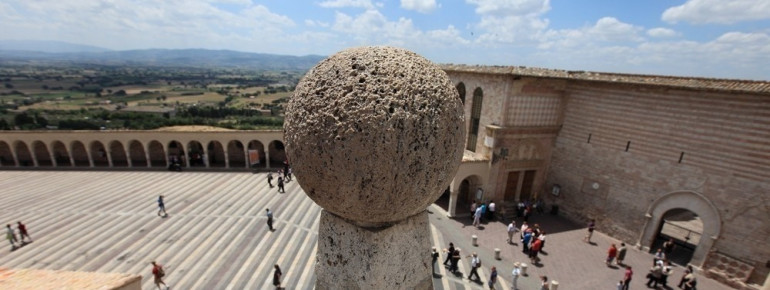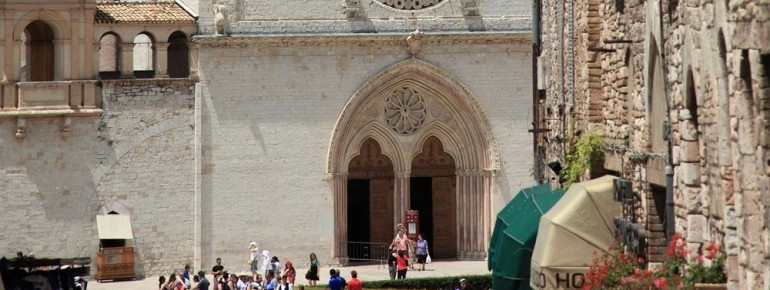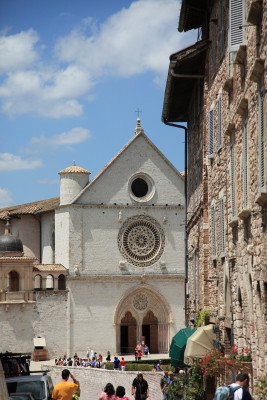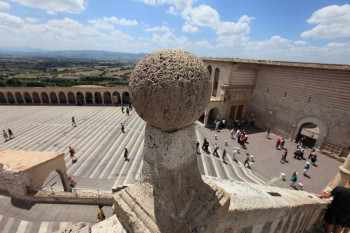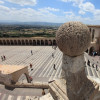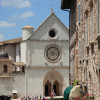Contents
Description
Architecture
The basilica is a so-called double church with a Basilica Superiore and an upper church as well as a Basilica Inferiore and a lower church. Interesting from an architectural point of view is the style, alternating between Romanesque and Gothic. So the lower church was constructed in a Romanesque style while the upper church was built after a Gothic model.
Lower church and Crypt
To enter the church there is a side entrance with two wooden doors. The lower church is composed of a nave and several side chapels. The nave's frescoes show Passion scenes as well as scenes of the life of Saint Francis. In addition the lower church is home of Saint Francis grave, which is located within the crypt.
Upper church
The Gothic part of the church is mostly known for its art historical influence. Mainly because of the grant fresco cycle inside, however theories about the artist are very controversial. They were made to show a connection between the lives of Saint Francis and Christ.
In contrast to the lower church, the upper church has only one nave. Other drawings by various painters inside the church were destroyed by an earthquake in 1997.
Historical Information
Former place of execution
The place were the church stands is historically very important. This was the former place of executions in Assisi. That is why Saint Francis wanted to be buried here, in remembrance of Christ, who was also executed.
Origin and benediction
The basilica was built in 1228 the same year Saint Francis was canonized by pope Gregor IX. In 1756 the church was then concecrated basilica maior and became one of the seven most senior churches of Catholicism.
Restoration
Since the church is built on a hillside water flows towards it on rainy days. This entailed that the buildings foundation was soaked many times during time, which has been especially hard on the Giotto frescoes. Over time they had to be restored a couple of times. Nowadays Assisi is equipped with a drainage system to redirect the water.
In 1997 then the nave as well as many other buildings in Assisi were destroyed by an earthquake. Consequently the church was substantially renewed and was opened for public two years later.
How to get there
By foot:
You may walk to Assisi via the Francis path. To do so start in Valfabbrica at Via San Benedetto and follow the signs „Via di Francesco“ to Assisi.
By car:
Coming from Perugia take Raccordo Autostradale 6 Bettolle/Perugia. Make a left at the first turn and follow the signs towards Assisi/Foligno/E45/Cesena until E45/SS3. At the exit Foligno continue driving towards Assisi/Spoleto/Aeroporto and onto SS75. Continue towards Assisi at the exit Assisi-S. M. Degli Angeli Sud.
Take the third exit within the roundabout and drive onto Via Fratelli Andrea a Nazareno Matteucci. Within the next roundabout take the first exit and thereafter the third exit. Continue on Via di Valecchie and turn left onto Localita Santa Peitro Campagna. Aferwards drive straight onto SR147 and continue onto Viale Guglielmo Marconi. Now turn right onto Via Fontebella, slightly left onto Via Eugenio Brizi, left again onto Via Ciotto and continue onto Via Portica. Then turn left onto Via San Paolo, continue onto Via Mestastasio and turn right onto Via Sermattei. Now take the first left turn and drive onto Via Cardinale Raffaele Merry del Val.
Eventually turn right onto Via San Francesco and further onto Via Frate Elia and you will arrive at Piazza San Francesco, where the basilica is located.

